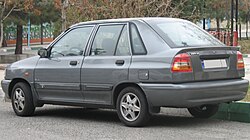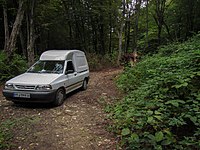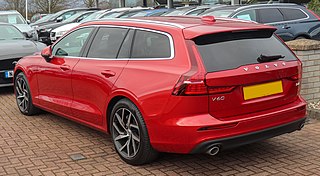
A station wagon or estate car, is an automotive body-style variant of a sedan with its roof extended rearward over a shared passenger/cargo volume with access at the back via a third or fifth door, instead of a trunk/boot lid. The body style transforms a standard three-box design into a two-box design—to include an A, B, and C-pillar, as well as a D-pillar. Station wagons can flexibly reconfigure their interior volume via fold-down rear seats to prioritize either passenger or cargo volume.

The Ford Festiva is a subcompact car that was designed and manufactured by Mazda for Ford between 1986 and 2002. Festiva was sold in Japan, the Americas, and Australia. The name "Festiva" is derived from the Spanish word for "festive". It was not related to the similarly sized and named Ford Fiesta, and was not replaced by the Ford Ka, which is smaller.

The Mitsubishi Galant is an automobile which was produced by Japanese manufacturer Mitsubishi from 1969 until 2012. The model name was derived from the French word galant, meaning "chivalrous". There have been nine distinct generations with total cumulative sales exceeding five million units. It began as a compact sedan, but over the course of its life evolved into a mid-size car. Initial production was based in Japan, but from 1994 the American market was served by vehicles assembled at the former Diamond-Star Motors (DSM) facility in Normal, Illinois.

The Mazda Luce is an executive car that was produced by Mazda in Japan from 1966 until 1991. It was widely exported as the Mazda 929 from 1973 to 1991 as Mazda's largest sedan. Later generations were installed with luxury items and interiors as the Luce became the flagship offering. The Luce was replaced by the Sentia in 1991 which was also exported under the 929 nameplate.
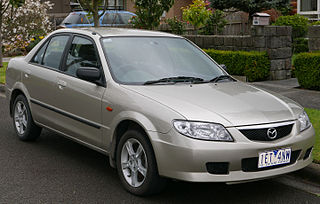
The Mazda Familia, also marketed prominently as the Mazda 323, Mazda Protegé and Mazda Allegro, is a small family car that was manufactured by Mazda between 1963 and 2003. The Familia line was replaced by the Mazda3/Axela for 2004.
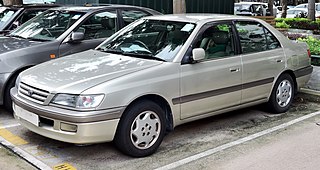
The Toyota Corona is an automobile manufactured by the Japanese automaker Toyota across eleven generations between 1957 and 2001. On launch, the Corona was Toyota's second-highest product in their range, just below the Crown. The Corona was marketed in the JDM at Toyota's Toyopet Store dealership channels, and the Corona was one of Toyota's first models exported to other global markets, followed by the smaller Toyota Corolla.

FSO Warszawa is an automobile manufactured in FSO factory in Warsaw, Poland between 1951–1973, based on GAZ-M20 Pobeda.

The Toyota Sprinter is a compact car manufactured by Toyota as a variant of the Toyota Corolla. Exclusively sold in the Japanese domestic market, the Sprinter was aimed to be sportier than its Corolla sibling and also using different sheet metal mostly on the C-pillar. The Sprinter was sold exclusively at the Toyota Auto Store while the Corolla was sold at the eponymous Toyota Corolla Store, which focused on economical cars compared to the more upmarket Vista store.

The Hyundai Pony, is a small automobile produced by the South Korean manufacturer Hyundai from 1975 until 1990. The Pony was South Korea's first mass-produced and exported car. It has a front-engine, rear-wheel-drive layout and variants were made with two-door coupé utility, three-door liftback, four-door saloon car, and five-door liftback or estate car body styles. The Pony nameplate remained in use until 2000 on some export versions of the Hyundai Excel and Accent.
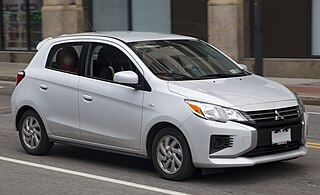
The Mitsubishi Mirage is a range of cars produced by the Japanese manufacturer Mitsubishi from 1978 until 2003 and again since 2012. The hatchback models produced between 1978 and 2003 were classified as subcompact cars, while the sedan and station wagon models, marketed prominently as the Mitsubishi Lancer, were the compact offerings. The liftback introduced in 1988 complemented the sedan as an additional compact offering, and the coupé of 1991 fitted in with the subcompact range. The current Mirage model is a subcompact hatchback and sedan and it replaces the Mitsubishi Colt sold between 2002 and 2012.

SAIPA is an Iranian automaker headquartered in Tehran. The SAIPAC was established in 1965 as with 75% Iranian ownership, to assemble Citroëns under license for the Iranian market. It changed its name into SAIPA in 1975 when Citroën withdrew from the company. Its products in recent years have been mostly under-licensed Korean cars and its own engine and range of cars. The chief executive of SAIPA is Javad Tavasoli Mehr.

The Kia Sephia is a compact car that was manufactured by the South Korean automaker Kia Motors from September 1992 to 2003.

The Kia Rio is a subcompact car manufactured by Kia from 1999 to 2023. Body styles have included a three and five-door hatchback and four-door sedan, equipped with inline-four gasoline and diesel engines, and front-wheel drive.

The Hyundai Accent, or Hyundai Verna is a subcompact car produced by Hyundai. In Australia, the first generation models carried over the Hyundai Excel name used by the Accent's predecessor. The Accent was replaced in 2000 by the Hyundai Verna in South Korea, although most international markets, including the US, retained the "Accent" name. The "Accent" name is an abbreviation of Advanced Compact Car of Epoch-making New Technology.

The Daewoo Lacetti is a compact car manufactured and marketed globally by GM Korea since 2002. The first-generation Lacetti was available as a four-door sedan and five-door station wagon, styled by Pininfarina—and five-door hatchback styled by Giorgetto Giugiaro. The sedan and wagon were marketed as the Daewoo Nubira in some European markets and as the Suzuki Forenza in North America. The hatchback, was introduced in 2004 and marketed as Daewoo Lacetti5 in South Korea, Suzuki Reno in the United States. After the 2004 model year, it was marketed as Chevrolet Nubira and Lacetti in Europe, as the Chevrolet Optra in Canada, Latin America, Africa, Middle East, India, Japan and Southeast Asia, and as the Holden Viva in Australia and New Zealand.

The Kia Bongo, also known as the Kia K-Series or Kia Besta, is a cabover pickup truck and van produced by the South Korean automobile manufacturer Kia since 1980.

The Moskvitch 2140 series is a small family car produced by Soviet automotive maker AZLK from January 1976 to 1988. It started first as Moskvitch 2138 and Moskvitch 2140 on a modified 412 platform. Pre-production models were shown during 1975. Starting in 1981, the modernised modification of the M-2140 export/luxury model was also designed and branded "2140 SL" in the Eastern Bloc countries and "1500 SL" outside. The most notable differences between the two models were redesigned dashboard and front seat headrests in the M-2140.

The Corolla E90, introduced in 1987 for the 1988 model year, was the sixth generation of cars sold by Toyota under the Corolla nameplate. It was the last generation of Corolla to be classified as a subcompact car and the first to be exclusively front-wheel drive or all-wheel drive; the performance option of rear-wheel drive was dropped.

The Daewoo Maepsy is a compact car manufactured by Daewoo in South Korea from December 1977 to 1989. The Maepsy was a badge engineered version of the Opel Kadett C, or to be more precise, of the PF50 Isuzu Gemini. Originally the car was sold as the Saehan Gemini, but in February 1982 the car evolved to become the Saehan Maepsy. By 1983 it was called the Daewoo Maepsy after Saehan Motor was bought out by the Daewoo Group, and finally the Daewoo Maepsy-Na. The word "maepsy" means "beautiful" in Korean.

The automotive industry in South Korea is the fifth-largest in the world as measured by automobile unit production and also the sixth-largest by automobile export volume.



